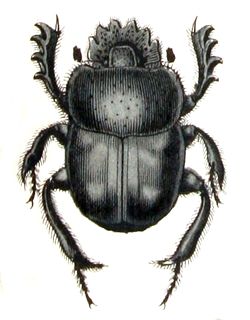| Scarabaeus | |
|---|---|
 | |
| Scarabaeus pius | |
| Scientific classification | |
| Kingdom: | Animalia |
| Phylum: | Arthropoda |
| Class: | Insecta |
| Order: | Coleoptera |
| Suborder: | Polyphaga |
| Infraorder: | Scarabaeiformia |
| Family: | Scarabaeidae |
| Subfamily: | Scarabaeinae |
| Tribe: | Scarabaeini |
| Genus: | Scarabaeus Linnaeus, 1758 |
| Synonyms | |
| |
The genus Scarabaeus consists of a number of Afro-Eurasian dung beetle species, including the "sacred scarab beetle", Scarabaeus sacer and is the namesake of the tribe Scarabaeini, the family Scarabaeidae, the superfamily Scarabaeoidea and the infraorder Scarabaeiformia. These beetles feed exclusively on dung, which they accomplish by rolling a piece of dung some distance from where it was deposited, and burying it in order to feed on it underground. They also prepare food for their larvae by excavating an underground chamber, and filling it with balls that have eggs laid in them. The growing larva feeds upon the dung ball, pupates, and eventually emerges as an adult. [2]
Contents
A "scarabaeus" is also a now outdated term (OED 2) for an object in the form of a scarab beetle in art. The scarab was a popular form of amulet in Ancient Egypt, [3] and in ancient Greek art engraved gems were often carved as scarabs on the rest of the stone behind the main flattish face, which was used for sealing documents. [4]
A creature identified as Scarabaeus appears in "The Gold-Bug" by Edgar Allan Poe, [5] and a poem entitled "Scarabæus sisyphus" was created by Mathilde Blind. [6]








